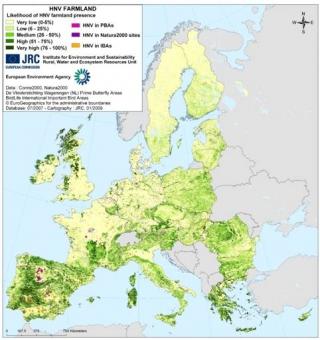Identifying And Supporting High Nature Value Farming Systems
Published on 6 May 2009 in Ecosystems and biodiversity

Introduction
The High Nature Value (HNV) farming concept recognises that many European habitats and landscapes considered to be of high nature conservation value are intimately associated with the continuation of specific low-intensity farming systems. The underlying principles behind the development of the HNV farming concept were, and remain, that:
• Market, agricultural policy and social pressures are increasingly making such HNV farming systems economically unviable
• Any resulting intensification or abandonment of such farming systems would adversely impact on the associated HNV
• There is therefore a justifiable case to be made for directing additional financial support to these farming systems to help maintain the HNV
The HNV concept has been adopted by the European Commission with the result that Member States are required to ensure that the Axis 2 (Sustainable Land Management) element of their 2007-2013 Rural Development Programmes (RDPs) are targeted at “…biodiversity and preservation of high nature value farming and forestry systems, water and climate change”.
Although some HNV farmland occurs in association with traditional cropping systems in southern Europe, in general the majority of Europe’s remaining HNV farmland is now largely associated with livestock grazing systems on semi-natural habitats in the mountains and other remote areas of Europe. Ensuring the maintenance of the farmland biodiversity value associated with such areas therefore depends on ensuring the continuation of appropriate low-intensity farming systems in those areas.
Key Points
The EU and all its Member States have committed themselves to three distinct actions concerning HNV farming:
Research Undertaken
Within SAC, we have been working closely with the European Forum on Nature Conservation & Pastoralism, and others, since 1995 not only to further develop the HNV farming systems concept but also to highlight the nature conservation importance of European HNV farming systems and the potential impacts of Common Agricultural Policy reforms on such systems.
For example, we coordinated a DG Research funded Concerted Action (PASTORAL: the agricultural, ecological and socio-economic importance of extensive pastoralism in Europe) and recently contributed to two projects informing the development of HNV farming guidance by the European Commission (High Nature Value (HNV) Indicators for Evaluation conducted for DG Agriculture and Developing a high nature value farmland indicator conducted for the European Environment Agency).
The latter two projects in particular highlighted the importance of determining HNV eligibility at the level of an individual farm (as opposed to simply a broad region) and provided an indication of the type of farm-scale criteria (such as habitat occurrence and stocking density characteristics) which could be used to identify such farms.
Policy Implications
A large proportion of Scotland’s farming systems, especially those practised on the islands and the hills and uplands, are potentially of High Nature Value. Implementing HNV requirements through the Scottish RDP potentially provides an opportunity to direct additional financial support towards HNV farming systems which are now known to be under greater threat following the European-wide changes to Common Agricultural Policy support mechanisms implemented in 2005.
There is a need not only to establish a baseline of how much HNV farming occurs in Scotland but also to develop mechanisms to track trends in that HNV farming resource within the life-span of the Scottish RDP. Scottish Natural Heritage are currently working to this end and considering how best to identify how much, and where, HNV farming occurs in Scotland.
There is also a further important need to consider what types of HNV farming-specific support mechanisms are required in Scotland and what policy framework is needed to ensure that such support can be developed and implemented effectively.
We are working to raise awareness of HNV farming issues in Scotland and help stimulate further discussions on how best Scotland’s HNV farming systems, and their associated biodiversity, can be supported and maintained into the future.
Author
Dr Davy McCracken davy.mccracken@sac.ac.uk







